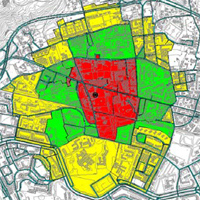Distribution to Retailers in the Metropolitan Area of Napoli
DOI:
https://doi.org/10.6092/1970-9870/166Keywords:
Napoli, distribution network for supplying retailersAbstract
The paper proposes a demand analysis and a re-engineering of the distribution network for supplying retailers in the metropolitan area of Napoli (Italy), carried out under the managing supervision of the local Association of Retailers. Notably, while there is a well-established set of infrastructural and operational solutions for more efficient distribution patterns leading to a reduction of freight vehicles•km in urban areas, the issue of their quantitative appraisal still deserves attention. This is also due, in the authors’ view, to the uncertainty in the transferability of (the few) quantitative methods for freight demand forecasts available in the literature to geographical contexts different from those they were implemented in. Firstly, the design and the outcomes of an extensive survey carried out within the metropolitan area of Napoli, in order to estimate the current freight demand, are presented. In more detail, the survey focused on the specific segment of retailers not belonging to a structured organization (i.e. department stores, newspapers, pharmacies, and so on), because of their intrinsic inefficiency and the consequent need for a substantial reorganization. Within this segment, 2.000 retailers (over about 30.000) have been surveyed, following a stratified sampling scheme by commodity group and geographical position. In more detail, six commodity groups (universe share in brackets: textile/clothing (33%), foodstuff (20%), household appliance and electronics (4%), furniture (5%), stationery (11%), other retailers (27%)) and nine territorial clusters (different for urban density, transport network performances and retailers’ characteristics) have been taken into account. As a result, a remarkable traffic has been observed, with some 27.000 consignments per day corresponding to about 260.000 packages. The main destinations are Napoli and its direct suburbs (about 24.000 consignments/day), the main origins are Napoli (9.000), its metropolitan area (11.000), the remaining of the region (2.000) and outside the region (5.000). Then, a re-engineering of the distribution network has been proposed and analyzed. In more detail, interest is primarily focused on rationalizing consignments coming from Campania and destined to the parts of the metropolitan area of Napoli with the highest population densities and road network congestion, that is the cities of Napoli, Nola, Castellammare di Stabia and Sorrento. The re-engineering is based on the introduction of 6 small transit points, three in the city of Napoli and one for each of the remaining cities, aimed at capturing all the consignments supplied within their area of influence, in order to support the protection of high valued urban areas. Notably, the re-engineering project took into account also the presence of significant intermodal nodes and logistic platforms within the study area, as potential higher-level platform for supplying transit points.Downloads
References
da Rios G. e Gattuso D. (2003). La mobilità delle merci nell’area metropolitana milanese, Franco Angeli.
d’Elia S., Festa D. C., Mazzulla G. (2006). Proposta di una struttura logistica per la distribuzione delle merci nell’area
urbana di Cosenza, Strade & Autostrade, n.2.
de Luca M, Pagliara F., Crisci L. (2007). Aree metropolitane in Italia e prospettive per il trasporto ferroviario, Atti del XIV Convegno nazionale SIDT, Napoli, Aracne Ed.
Regione Emilia Romagna, Assessorato Mobilità e Trasporti (2005) Progetto CITYPORTS, Logistica urbana a Bologna: elementi per un progetto, Quaderno del Servizio di Pianificazione dei Trasporti e Logistica n.8.
Uniontrasporti (2008). City logistics: strategie d’intervento per il rifornimento delle reti commerciali al dettaglio. Proposta di transit point urbani per la provincia di Napoli. Rapporto finale.

Downloads
Published
How to Cite
Issue
Section
License
Authors who publish in this journal agree to the following:
1. Authors retain the rights to their work and give in to the journal the right of first publication of the work simultaneously licensed under a Creative Commons License - Attribution that allows others to share the work indicating the authorship and the initial publication in this journal.
2. Authors can adhere to other agreements of non-exclusive license for the distribution of the published version of the work (ex. To deposit it in an institutional repository or to publish it in a monography), provided to indicate that the document was first published in this journal.
3. Authors can distribute their work online (ex. In institutional repositories or in their website) prior to and during the submission process, as it can lead to productive exchanges and it can increase the quotations of the published work (See The Effect of Open Access)

